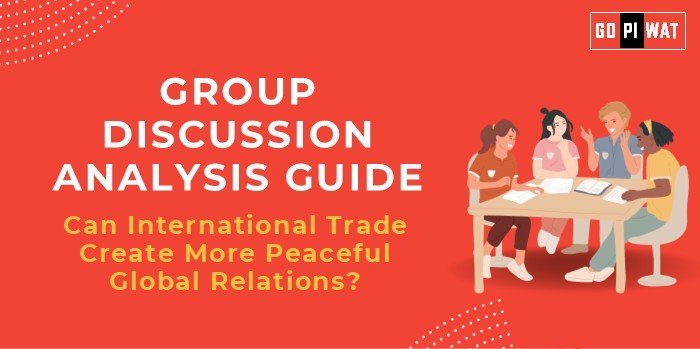📋 Group Discussion (GD) Analysis Guide
🌍 Can International Trade Create More Peaceful Global Relations?
💡 Introduction to the Topic
🌱 Opening Context: “In an increasingly interconnected world, the power of international trade as a catalyst for peace remains a cornerstone of diplomatic discussions. With trillions of dollars exchanged globally, trade serves not only as an economic engine but as a conduit for collaboration and understanding between nations.”
📜 Topic Background: The link between trade and peace is rooted in classical economic theories like those of Montesquieu and Kant, which assert that trade interdependence reduces conflict likelihood. Modern-day institutions like the WTO and regional trade agreements aim to strengthen this premise.
📊 Quick Facts and Key Statistics
- 📈 Global Trade Volume (2024): $32 trillion – reflects the scale of economic interdependence.
- 🌐 Countries Engaged in FTAs: Over 300 agreements worldwide – shows growing reliance on trade for economic ties.
- 📉 Conflict Reduction Statistics: Nations with $1B+ trade relations have a 15% lower conflict probability (UNCTAD, 2023).
- 🌍 Trade as GDP Percentage: 61% globally – indicates the economic reliance on international trade.
🌍 Stakeholders and Their Roles
- 🏛️ Governments: Set trade policies and participate in international agreements.
- 🏢 Private Corporations: Drive economic activities across borders.
- 🌐 International Organizations (e.g., WTO, IMF): Facilitate and regulate trade.
- 👥 Civil Society: Advocates for fair trade practices and sustainable development.
🏆 Achievements and Challenges
🌟 Achievements:
- ✔️ Economic Growth: Increased trade boosts GDP; for example, ASEAN nations collectively saw a 5% GDP growth due to RCEP.
- ⚖️ Conflict Resolution Mechanism: Trade agreements like USMCA include dispute resolution frameworks.
- 🌍 Global Supply Chains: Promoted interdependence reducing unilateral actions.
⚠️ Challenges:
- 📉 Economic Inequalities: Disparities between developing and developed nations.
- 🔗 Dependency Risks: Over-reliance on trade can become a tool for coercion.
- ⚔️ Geopolitical Conflicts: Trade wars, such as US-China tariffs, can escalate tensions.
🌍 Global Comparisons:
- 🇪🇺 EU: A trade-based union fostering peace among 27 nations.
- 🇨🇳 China-ASEAN Trade: Built resilience despite territorial disputes in the South China Sea.
📜 Case Studies:
- 🇺🇸 US-Mexico-Canada Agreement (USMCA): Improved labor rights and reduced trade disputes.
- 🇮🇳 India-UAE CEPA: Strengthened relations through a $100 billion trade target.
✨ Structured Arguments for Discussion
- 💬 Supporting Stance: “Trade interdependence diminishes incentives for conflict by increasing economic stakes in peace.”
- ⚖️ Opposing Stance: “Economic gains from trade do not always translate to peaceful relations, as seen in US-China tensions.”
- 🔄 Balanced Perspective: “While trade promotes collaboration, its efficacy as a peace tool is contingent on equitable agreements and conflict resolution mechanisms.”
🎯 Effective Discussion Approaches
📖 Opening Approaches:
- 📊 “The $32 trillion global trade volume highlights the immense potential of economic interdependence to foster peaceful relations.”
- 📜 “Historical precedents like post-WWII Europe illustrate the transformative power of trade in securing peace.”
🔄 Counter-Argument Handling:
- 🔍 Rebut economic dependency concerns by suggesting diversification.
- ⚙️ Counter geopolitical exploitation risks with multilateral frameworks.
📈 Strategic Analysis of Strengths and Weaknesses
- 💪 Strengths: Promotes economic growth, reduces conflict likelihood, builds global ties.
- ⚠️ Weaknesses: Can exacerbate inequality, prone to manipulation.
- 💡 Opportunities: Strengthening multilateralism, expanding digital trade.
- 🚨 Threats: Geopolitical tensions, trade wars.
📚 Connecting with B-School Applications
- 🌟 Real-World Applications: Topics for research include trade policy analysis and supply chain risk management.
- 💬 Sample Interview Questions:
- “How does international trade influence conflict resolution?”
- “Can free trade agreements mitigate geopolitical tensions?”
- 📖 Insights for B-School Students:
- Explore digital trade’s potential in fostering peace.
- Analyze the impact of trade policies on global relations.


